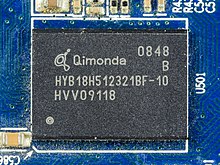|
GDDR3 SDRAM
  GDDR3 SDRAM (Graphics Double Data Rate 3 SDRAM) is a type of DDR SDRAM specialized for graphics processing units (GPUs) offering less access latency and greater device bandwidths.[compared to?] Its specification was developed by ATI Technologies in collaboration with DRAM vendors including Elpida Memory, Hynix Semiconductor, Infineon (later Qimonda) and Micron.[1] It was later adopted as a JEDEC standard. OverviewIt has much the same technological base as DDR2, but the power and heat dispersal requirements have been reduced somewhat, allowing for higher performance memory modules, and simplified cooling systems. GDDR3 is not related to the JEDEC DDR3 specification. This memory uses internal terminators, enabling it to better handle certain graphics demands. To improve throughput, GDDR3 memory transfers 4 bits of data per pin in 2 clock cycles. The GDDR3 interface transfers two 32 bit wide data words per clock cycle from the I/O pins. Corresponding to the 4n-prefetch a single write or read access consists of a 128 bit wide, one-clock-cycle data transfer at the internal memory core and four corresponding 32 bit wide, one-half-clock-cycle data transfers at the I/O Pins. Single-ended unidirectional Read and Write Data strobes are transmitted simultaneously with Read and Write data respectively in order to capture data properly at the receivers of both the Graphics SDRAM and the controller. Data strobes are organized per byte of the 32 bit wide interface. Commercial implementationDespite being designed by ATI, the first card to use the technology was nVidia's GeForce FX 5700 Ultra in early 2004, where it replaced the GDDR2 chips used up to that time. The next card to use GDDR3 was nVidia's GeForce 6800 Ultra, where it was key in maintaining reasonable power requirements compared to the card's predecessor, the GeForce 5950 Ultra. ATI began using the memory on its Radeon X800 cards. GDDR3 was Sony's choice for the PlayStation 3 gaming console's graphics memory, although its nVidia based GPU is also capable of accessing the main system memory, which consists of XDR DRAM designed by Rambus Incorporated (Similar technology is marketed by nVidia as TurboCache in PC platform GPUs). Microsoft's Xbox 360 has 512 MB of GDDR3 memory. Nintendo's Wii also contains 64 MB of GDDR3 memory. Advantages of GDDR3 over DDR2
See alsoReferences
External links |
||||||||||||||||
Portal di Ensiklopedia Dunia
